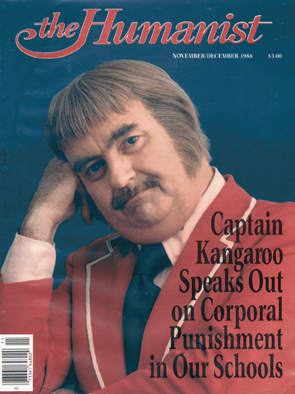On Oct. 3, 1955, Bob Keeshan stepped onto a nautical-themed set wearing a captain's cap and a jacket with big, kangaroolike pockets. He smiled into the camera and became a television icon.Keeshan would play Captain Kangaroo for 36 years--more than 9,000 performances--to the amusement and betterment of generations of delighted children.
Keeshan died Friday at a hospital in Windsor, Vt., after a long illness. Though no cause of death was announced, he had suffered from cardiac problems since the 1980s. He was 76.
Unmistakable with his brushy mustache and bowl haircut, the Captain passed time with his good friend Mr. Green Jeans (Hugh "Lumpy" Brannum), visited with puppet animals such as Bunny Rabbit, whom he scolded for eating too many carrots, and Mr. Moose, who loved knock-knock jokes. The animal characters were voiced by Cosmo "Gus" Allegretti.
Ahead of his time in recognizing the importance of early learning, Keeshan's Captain built confidence and intellectual development in children who were having too much fun to notice the lessons.
"Play is the work of children," he said. "It's very serious stuff. And if it's properly structured in a developmental program, children can blossom."
His first television appearance was in 1948 on "The Howdy Doody Show" as a voiceless, horn-honking clown named Clarabell. He later played Corny the clown, host of a noontime cartoon show out of New York. In 1990, he was inducted into the Clown Hall of Fame.
But it was Captain Kangaroo most will remember--a grandfatherly figure (though Keeshan was just 28 at the beginning) who spoke directly to the camera, with no audience, no children in the cast, no intermediaries in the conversation he was having with his at-home viewers.
"One of the reasons I work in television today," said David Kleeman, executive director of the Chicago-based American Center for Children and Media, "is because, when I was 4 or 5, I said `Hello' to Captain Kangaroo when he came on the screen, and he said `Hello' back to me. I really believed that he was talking to me. And I think he would have agreed. We're losing the generation of children's TV hosts who made a new mass medium personal--who could talk into the camera as though we were the only person on the other side."
"When `Captain Kangaroo' first appeared, there was a lot of criticism," said Jennings Bryant, director of the Institute for Communication Research at the University of Alabama. "It was said that children needed television that made them face the harsh realities of life. Keeshan's response was, `That's what everybody else is doing.'"
Bryant noted that academic studies have bolstered Keeshan's philosophies about learning and that even more curriculum-driven shows such as "Sesame Street" now incorporate what he called the "pro-social" approach identified with Keeshan.
In later life Keeshan spoke often about the importance of good parenting.
`Role models'
"Parents are the ultimate role models for children," he said. "Every word, movement and action has an effect. No other person or outside force has a greater influence on a child than the parent." [Emphasis added]
The show wasn't an instant success, but CBS believed in the show and kept it going. The show ultimately found its audience and had a substantial viewership, going toe to toe with the mighty "Today" show on NBC. As formidable as "Today" was, children knew that it wasn't going to offer Tom Terrific or Mighty Manfred the Wonder Dog or Dancing Bear or the Magic Drawing Board. The show moved to PBS for its last six seasons.
After Fred Rogers, host of "Mister Rogers' Neighborhood," died last year, Keeshan recalled conversations they had about programming for children.
"I don't think it's any secret that Fred and I were not very happy with the way children's television had gone," he said.
Needs haven't changed
"Ultimately," said longtime Chicago television personality John Callaway, "he was about decency and dignity in the midst of all the silliness. I hope he'll represent something to future programmers of children's television. Though children have changed, what has not changed is their needs. Sometime, late in an evening, those programmers should pull out a tape."
Read THE TIME IS NOW by Bob Keeshan.

Keeshan insisted that viewers must always feel special, never just part of a huge audience. He screened advertising to assure that what he considered exploitative commercials would never be shown.
Over the years, his stewardship of "Captain Kangaroo" was abundantly rewarded. The show won six Emmy Awards, three Gabriels for "uplifting" programming from a Catholic media group and three Peabody Awards.
Keeshan, born in Lynbrook on Long Island on June 27, 1927, was an NBC page making $13.50 a week while in high school. He attended Fordham University and served in the Marine Corps Reserves in the last years of World War II. After the war, he returned to his job at NBC and was assigned to a reception desk next to the office of a newly arrived radio personality, Buffalo Bob Smith. Smith's radio show would evolve into "The Howdy Doody Show" and provide Keeshan with a job.
In 1950, Keeshan married Anne Jeanne Laurie. He was a member of many boards, including the West Islip Board of Education from 1953 to 1958. "We've elected a clown to the board of education," The New York Times quoted a resident as saying then.
Keeshan's wife died in 1990, and he moved to Vermont, remaining active as an advocate for children, writing books, lecturing and lobbying on behalf of children.
Copyright © 2004, Chicago Tribune